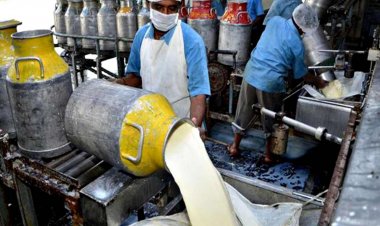How India wrote a success story in Sugar Export, can cross $5.5 billion by march end
end of the current year, March 31, 2023, India's sugar exports can cross $ 5.5 billion i.e. about Rs 45,000 crore. For this sugar season (October 2022 to September 2023), the government has issued a quota of 61 lakh tonnes of sugar exports. Out of this, about 55 lakh tonnes have been already exported and the remaining quantity will also be exported soon.

In the last four years, India has written a new chapter in the matter of sugar exports. The ever-increasing production has led to a huge increase in exports and the sugar industry has created many markets, including Asian and African countries. This success has been achieved by India establishing itself as a reliable sugar exporter.
By the end of the current year, March 31, 2023, India's sugar exports can cross $ 5.5 billion i.e. about Rs 45,000 crore. For this sugar season (October 2022 to September 2023), the government has issued a quota of 61 lakh tonnes of sugar exports. Out of this, about 55 lakh tonnes have been already exported and the remaining quantity will also be exported soon.
The industry was expected to be allowed to export around 8 million tonnes of sugar but the government is yet to release the additional quota. Due to which sugar prices have remained much better in the global market.
A sugar industry source told Rural Voice that currently the FOB (free on board) price of London white sugar is running at $586 per tonne, which is an FOB price of Rs 4,510 per quintal for India. The New York price for Raw Sugar is 20.76 cents which is Rs.3,935 per quintal for India. From this level of prices, it can be estimated as to how much the Indian sugar industry is benefiting from exports.

According to information received by Rural Voice from the sugar industry, sugar mills in Maharashtra are getting ex-mill price of Rs 3,215 to Rs 3,255 per quintal for ‘S’ grade sugar in the domestic market. On the other hand, sugar mills of Uttar Pradesh are getting ex-mill price of Rs 3,410 to Rs 3,510 for ‘M’ grade sugar.
Some other price tags are Rs 3,180 to Rs 3,220 per quintal for ‘S’ grade for Karnataka sugar mills, Rs 3,340 to Rs 3,400 per quintal for ‘M’ grade for Gujarat mills and Rs 3,300 to Rs 3,350 per quintal for Tamil Nadu sugar mills for ‘S’ grade sugar. In Indian sugar, ‘S’, ‘M’ and ‘L’ are used to denote the crystal size of the sugar particles. 'S' means small, 'M' means medium, and 'L' means large. Retail price of sugar in the country is Rs 41.73 per kg. The above figures make it clear that sugar mills are getting huge benefits from exports.
This export market is proving to be a golden egg for sugar mills, but the farmers of the country are not getting that much benefit from it. Farmers in Uttar Pradesh, the country's second largest sugar producing state, have got an increase of only Rs 35 per quintal in the State Advisory Price (SAP) of sugarcane in the last six years.
Out of the last six years, the SAP of sugarcane has been frozen here for four years and it has increased only twice, while the farmers are facing losses due to increase in the cost of production.
Sugar was exported from India in the year 2017-18 to $ 81.09 million, which increased to $ 4.6 billion in 2021-22. Sugar exports are likely to reach $5.5 billion in the current financial year. In the sugar season of 2016-17 (October to September), 46,000 tonnes of sugar was exported, which was 6.2 lakh tonnes in the next year 2017-18. In 2021-22, it increased to 110 lakh tonnes.
India is exporting both Raw Sugar and White Sugar. Importers refine the raw sugar in the refinery and converts it into white sugar. The ICUMSA value of raw sugar is 1200 or more. While the ICUMSA value of white sugar is less than 45. International Commission for Uniform Method of Sugar Analysis (ICUMSA) is also called ICUMSA value.
Till a few years back India exported only white sugar and the share of raw sugar in exports was very less. Raw sugar has a high share in the export market in the world. It is easy to export. This option was initiated in 2018 when a delegation of industry and government officials led by Joint Secretary, Ministry of Food and Civil Supplies and industry representatives visited Indonesia, Malaysia, South Korea, China and Bangladesh.
The closing stock for the season ending September, 2018, was 10.5 million tonnes. Due to which the availability of sugar in the country was high and the prices were weak. Raw sugar can be exported through bulk vessels of 40,000 to 70,000 tonnes, while white sugar is packed and exported through containers.
Raw sugar is imported by the companies that refine it. With this, one advantage is that India has more production between November and April, while Brazil, the largest sugar exporting country, exports sugar only between April and November.
Thus, India had an opportunity to export sugar in the off season of Brazil. While it takes about 15 days for sugar from India's Mundra, Kandla and JNPT Nwashawa to Siwandan port in Indonesia, it takes about 45 days for sugar from Brazil. At the same time, the quality of Indian sugar for refining is better than that of Brazil, Thailand and Australia.
According to an official of the sugar industry, we made importers aware about the benefits of India's raw sugar. Due to which India's raw sugar is currently being sold at a four per cent premium to international market prices.
On the other hand, in the case of refined sugar, for which India gets $ 40 less per tonne in the international market. In the case of raw sugar, Indonesia has cleared the way for its import from India by changing its ICUMSA standards in December 2019. The country which earlier used to import raw sugar of 1200 or more ICUMSA from Thailand has approved the norms for importing sugar of 600 to 1200 ICUMSA from India so that the refiners there can import raw sugar from India. Indonesia exports palm oil to India, in its favour it reduced the import duty on Indian sugar from 15 per cent to five per cent.
The result of these steps was that the share of raw sugar reached 56.29 lakh tonnes out of the total 110 lakh tonnes of sugar exports in 2021-22. That is, more than half of the sugar was exported in the form of raw sugar. In this, Indonesia bought maximum 16.73 lakh tonnes of raw sugar.
After that, Bangladesh imported 12.10 lakh tonnes, Saudi Arabia 6.83 lakh tonnes, Iraq 4.78 lakh tonnes and Malaysia 4.15 lakh tonnes. Whereas, out of 53.71 lakh tonnes of white sugar exported from the country, 7.54 lakh tonnes was imported by Afghanistan, 5.17 lakh tonnes by Somalia, 4.90 lakh tonnes by Djibouti, 4.27 lakh tonnes by Sri Lanka, 2.58 lakh tonnes by China and 1.08 lakh tonnes by Sudan.
Due to this success, India has become the world's second largest sugar exporter from a minor exporter a few years ago. According to the International Sugar Organization, Brazil exported 255.40 lakh tonnes of sugar in the year 2021-22, followed by India with 110.58 lakh tonnes of sugar, while Thailand followed India by exporting 79.86 lakh tonnes of sugar. This year Australia has exported 25.67 lakh tonnes of sugar.
The highest closing stock in the country was in the sugar year of 2018-19 when it reached 143 lakh tonnes but it came down to 70 lakh tonnes at the end of 2021-22. On the other hand, the production of sugar in the current year is expected to go up to 334 lakh tonnes as against last year's 359.25 lakh tonnes.
Because of this, the government limited the export of sugar to 61 lakh tonnes for the current year. Out of this, almost entire sugar deals have been done and more than 50 lakh tonnes of sugar has been exported.



 Join the RuralVoice whatsapp group
Join the RuralVoice whatsapp group









































